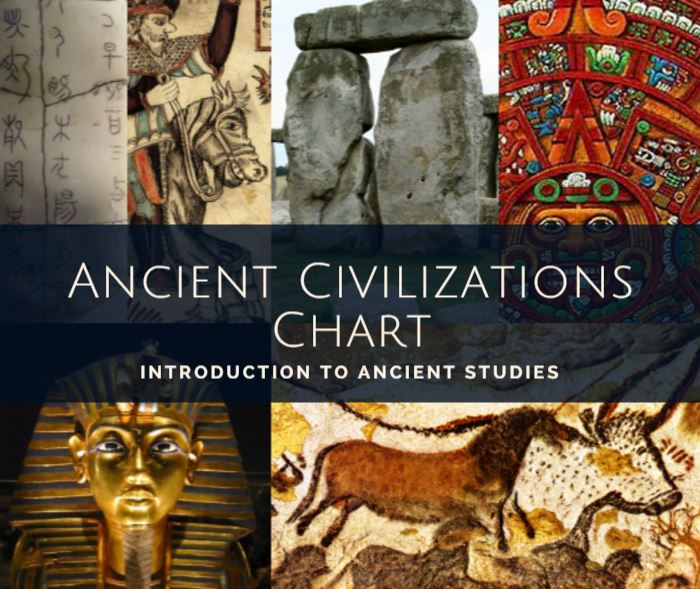Chart: Ancient Civilizations of the World
Contents
In this article, we will analyze the fundamental factors of civilizations and determine what were the most ancient civilizations of the world through a visual chart and extensive descriptions.
1. Fundamental Ffactors of Civilizations
The concept of civilization has two levels. It refers as much to the moral values of a society as it does its materials. Karl Marx distinguishes infrastructure (materials) from superstructure (spiritual). This duality has made many current authors distinguish between culture and civilization, associating the first term with the dignity of the spiritual and the second with the triviality of the material. But, without a doubt, civilizations are heavily marked by the development of the diverse cultures that, many times, manifest themselves within them and that make up the foundation of their material development.
At present, specialists have reached a consensus that there is not one civilization, but rather several civilizations and they have put judgments of which is better than the other aside in their analysis. Thus, the singular word ‘civilization’ is related to those common goods and elements that are distributed variably between all civilizations, e.g.: fire, writing, calculus, domestication of plants and animals. Or it may refer to the goods to which no particular origin is attributed (or whose origin is linked to the development of the ancient world’s first civilizations and have become part of human heritage) and have become the collective goods of civilization.
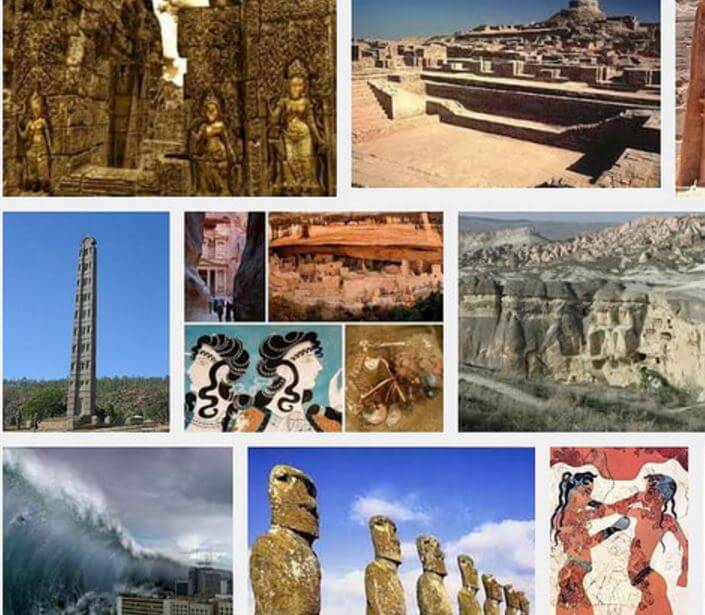
Civilizations are composed of 4 factors:
- Spaces: Consisting of land, relief, climate, vegetation, animal species and all the consequences that this has for man: agriculture, livestock, food, house, clothing, communication, industry, etc. In other words, the stage on which life develops.
- Societies: shaped by people in their dynamic of continuous interaction, who are carriers and in turn transmitters of a civilization. Thus, it is societies that sustain civilizations and encourage them with their tensions and progress. These societies are based on hierarchical relationships, with strong differences between the groups and, therefore, they generate social conflicts, from political struggles, and consequently continuous evolution. These societies shape forms of political organization to regulate their coexistence, which determines the states’ development.
The most important signal that distinguishes between cultures and civilizations is without a doubt, the presence or absence of cities. Cities spread in civilizations while they scarcely show up in cultures. - Economies: Every civilization is determined by economic, technical, biological, and demographic information. Material and biological conditions are always an important factor in the fate of civilizations. The increase or decrease of a population, hygiene and health conditions, economic growth or stagnation, and scientific and technological development have a social and cultural impact and allow for higher levels of development.
- Collective mentalities: Perhaps what is the most characteristic, most incommunicable aspect that civilizations share, and what isolates and distinguishes them best, is the set of fundamental values that make up their collective psychology. These mentalities are also insensitive to time, changing very slowly. In this respect, religion is the predominant figure in the heart of civilizations, both in its past and present.
Finally, it should be noted that civilizations evolve and take place over a long period of time.
2. The First Civilizations of the Ancient World
Ancient Civilizations Chart
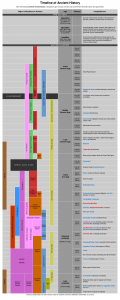
The first civilizations emerged in the geographic area called the Ancient Near East, comprising Northeast Africa and Southeast Asia between the years 3500 and 250 BC. Man settled in this region after a very long period of prehistoric roaming, from appearances on the terrestrial surface, giving rise to the first human groups along the valleys of the Tigris, Euphrates, and Nile rivers. This region was the birthplace of the first civilizations, thus beginning a long process of changes and influences that shaped Western civilization.
However, although it is true that Mesopotamia and Egypt are considered to be the oldest civilized centers, other regions existed in the Far East, in the Indus River valley in India, and the Yellow River in China. In these areas, there were also very old civilized nuclei, whose influence was limited to adjacent geographic areas.
The first men and first civilizations arose in Africa and Asia:
Throughout prehistory, for a period of a million years, humans lived a nomadic life following herds of animals that gave them meat for food, leather for shelter and bones for tools and weapons. Throughout the existence of these men, who lived during the last glaciation (40,000 years ago), the climate was extremely severe; but by 6000 BC, a ‘climatic optimum’ occurred. The valleys of the great rivers, which were previously nothing more than wide marshy plains, were transformed into enormous mud deposits in which vegetation almost spontaneously emerged.
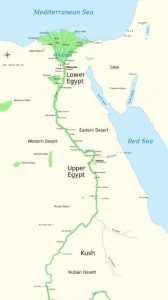
This was the case in the valley of the River Nile, which made it a center of demographic attraction. The same thing occurred with the fertile plains between the Tigris and the Euphrates; consequently, human, cultural and political expansion occurred along the course of the rivers. Favorable climatic conditions, along with the development of agriculture, were two factors that influenced the emergence of important civilizations. Man’s food was assured thanks to the wealth of the land and, collectively united, mankind developed its creative ability along with its natural desire to perfect itself and achieve a higher standard of living.
Read also: Ancient African Civilizations
The first villages appeared in the mountainous territories of present-day Iraq, next to the Tigris and Euphrates rivers; the fertile land provided numerous berries (the first crops were limited to cereals, such as wheat and barley), they sowed and harvested using rudimentary tools (crude sickles made from bone or flint), and animals were abundant. Under these conditions, man became accustomed to living in a fixed place, becoming sedentary, ready to build more solid houses, erect monuments that perpetuated their religious ideas, etc.
Factors that influenced the origin of civilizations.
- The discovery of agriculture.
- The domestication of animals.
- The birth of cities.
- The development of commerce.
- The centralization of politico-religious power in a powerful priest-king.
- The creation of a permanent army.
Comparison of Ancient Civilizations
Civilization 1: Ancient Egypt
- People of Hamitic origin, with Semitic influence.
- Located in the so-called ‘Fertile Crescent’, the cradle of Western civilization.
- In the Northeast of Africa, between the Libyan Desert (in the west) and Arabic mountains (in the east).
- Egypt runs from south to north along the River Nile, which allows for the country’s fertility. This is why Egypt is ‘a gift of the Nile’.
- Territorial division in Lower Egypt (the Nile Delta), capital Memphis, and Upper Egypt (the Nile Valley), capital Thebes.
Politics
In its earliest days, Egypt was divided into small states or ‘nomes’, under the control of hereditary princes, in charge of civil, military, judicial administration and worship (officiated by the high priest).
During the Old Kingdom (3200 – 2400 BC), with Memphis as the capital, King Menes unified Egypt and the pharaonic dynasty (First to Fifth dynasties) began. Bureaucracy under royal officials (scribes) and governmental centralization arises.
The Pharaoh, with absolute power, has a divine character as he is the son of the sun god. In the Intermediary Period (2400 – 2000 BC), the god Ra rises above the pharaoh. Governors become masters and lords of their districts. The monarchy decays and anarchy takes over Egypt.
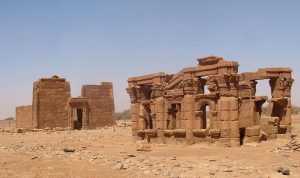
In the Middle Kingdom (2000 – 1788 BC), unity is restored thanks to the princes of Thebes, pharaohs don’t govern at all as nobles control the districts (administrative decentralization).
Expansion into Nubia. However, the country returns to anarchy, being dominated by a mixed Indo-European and Semitic people: the Hyksos.
During the New Kingdom (1580 – 1085 BC), the country is liberated again by the princes of Thebes. At this stage, the pharaoh governs absolutely through a centralized administration. There was now a standing army and warrior nobility.
Eastern expansion: Thutmose III (1480 – 1450 BC) subdued Palestine, Phoenicia, and Syria. Garrisons were established in these places, preserving the customs of the conquered peoples. Through diplomacy, they managed to maintain friendly relations with the Asian princes and establish harmony in the East. The Pharaoh seeks to make his mark on history, worships with temples dedicated to the gods, celebrates feasts and provides his subjects with a good life.
The religious reform of Amenophis IV led to the division of the people, hatred of the pharaoh and anarchy. The Syrian and Palestinian princes became independent. The universal empire was destroyed.
With the Nineteenth and Twentieth dynasties (1350 – 1085 BC), the pharaohs temporarily re-establish power. With Ramses II, internal and external peace was achieved, but Egypt saw its sphere of influence reduced, preoccupying itself with defending itself from foreign powers in future.
After the Twentieth dynasty, the power struggle between the priesthood of Amun, Libyan mercenaries, the kings of Nubia, and Assyrian rule (671 BC) led the country into a worrisome situation. This was only overcome thanks to the Twenty-sixth dynasty, the Saite Period (663 BC), which sought to revive the state by imitating the glorious ways of the past and establishing close economic and cultural relations with the Greeks. However, an external incident, the destruction of the Assyrian Empire and the formation of the Persian Empire, would lead to the Pharaohs being unable to defend themselves against the new power and defeated in the Battle of Pelusium in 525 BC. Egypt then became a Persian province.
Society
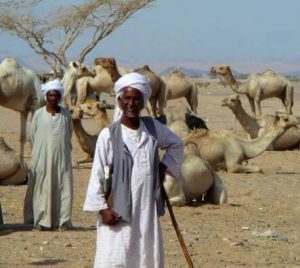 The first inhabitants were nomadic hunters, who established themselves in the Nile valley, dedicating themselves to working the land.
The first inhabitants were nomadic hunters, who established themselves in the Nile valley, dedicating themselves to working the land.
The acquisition and accumulation of land, wealth, and power eventually led to a strong social division between the ruling class (royal family, royal officials, and priests), merchants and craftsmen and a multitude of servants (slaves).
These were not closed castes, but generally, the son inherited the father’s occupation.
Economy
In the initial years, its inhabitants dedicated themselves to collectively working the land. However, with time, specifically from the Old Kingdom onwards, activities diversified. As agriculture developed, so did commerce (they engaged in commercial relations with the peoples of Western Asia), craftsmanship, mine works, and quarries.
Religion
In early times, fetishism (spirits that were incarnated in animals) was the main religious manifestation, accompanied by the belief in a tutelary god for each city (Thebes had the ram Amun; in Memphis, Ptah, and the ox Apis). In a second stage, the anthropomorphic cult arose (belief in a god with a human body and an animal’s head). Superior gods appeared, associated with the sun: Ra (Amun-Ra). They also worshiped Ra’s son, Horus (the rising sun), Seth, the god of darkness, and Osiris, the god of the setting sun. In the early days, they were not cults and only served as an explanation of natural phenomena. Over the centuries, human sacrifices to the deities were frequent. The Egyptians even worshiped good gods as much as evil ones with the same vigor, as they considered them to be superior to any man and such power should be venerated. During the New Kingdom, Amun-Ra became the sole and supreme god, the creator of the universe (true monotheism), although people continued to practice polytheism.
The priests held an elevated position as the mediators between the gods and men. They were the only teachers at schools, located in the temples. They nurtured the sciences. Their position was hereditary. The great earthly and spiritual power that the high priest had during the New Kingdom led to the weakening of the state and the pharaoh. The religious reform of Amenophis IV or Akhenaten ‘Effective for Aten’ (1370 – 1352 BC) led to the worship of a single god (monotheism), a new form of the solar god, Aten (‘solar disk’), the god of love and goodness. The king declared himself the high priest of the new god, destroying the temples and images dedicated to the other gods and expelling the priests. The new religion imposed moral duties on men. Contrary to these changes, once Amenophis disappeared the people returned to their ancestral religious practices (worship of Amun-Ra and the other gods), materialism trumping spirituality.
In regards to death, the Egyptian belief was related to the ‘ka’, i.e. the spirit of each man, which inhabited a body. That’s why at the moment of death the corpse was mummified so that the spirit could continue to dwell within it for eternity. Later, they thought that the soul left the body and entered the world of the gods after passing through the so-called ‘judgement of the dead’. This, in a certain way, allows us to understand the importance placed on the acts a man committed during life, which reflects a relative spirituality. In spite of this, mummification was not abandoned.
Cultural advances
- They developed hieroglyphic (ideographic) writing.
- Their structural funeral monuments stand out: the pyramids, especially those in Giza (Khufu, Khafre, and Menkaure), and the construction of mastabas and hypogea (underground tombs preferentially located in the Valley of the Kings).
- Temples in honor of the gods stand out for their grandeur; this is the case with the temples of Karnak and Luxor in Thebes dedicated to Amun-Ra. These monumental works built with stone were born of the desire to materially express the infinite and the eternal.
- They also made important advances in medicine, mathematics, and astronomy, with the last one resulting in a very exact calendar year of 365 days divided into twelve months, the last of which had five days remaining at the end. The works utilizing the waters of the River Nile had particular development, constructing dikes and irrigation channels.
Civilization 2: Ancient Mesopotamia
Location
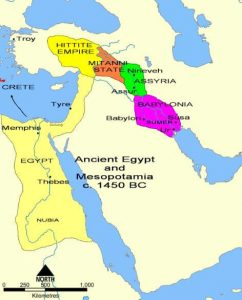
Inhabited by Semitic and Indo-European peoples who spread throughout the fertile lands surrounded by the Euphrates and Tigris rivers. Mesopotamia or ‘the country between two rivers’ (the Euphrates and the Tigris) as the Greeks called it, is situated between Armenia, the mountains of Kurdistan, the Syrian-Arabian desert and the Persian Gulf. It is also part of the so-called ‘Fertile Crescent’.
Mesopotamia is divided into two regions: Assyria (the northernmost and mountainous part) and Babylonia (southern part, an almost flat fertile plane) or Chaldea.
Its climate is warm and dry, and Mesopotamia would be a sterile steppe if it weren’t for the Euphrates and the Tigris, which are born in the Armenian mountains. Annually in April and May, when the snow melts, they flood the country with their waters.
Economy
Thanks to artificial irrigation, Mesopotamia was one of the most fertile countries, with three harvests a year, rich in cereals and vineyards. Among the wildlife were lions, gazelles, ostriches, as well as wild dogs, cats, sheep, and donkeys, which had already been domesticated a long time ago. A peculiar product was gasoline, from which asphalt was extracted.
Society
The first inhabitants of Mesopotamia were shepherds and nomads who organized themselves around the collective work and into political organisms with strong authority. Their political organization was the tribe, based on a patriarchal system and the idea of a consanguineous community. All members of the tribe are free and equal, there aren’t any social differences. Only the elderly enjoyed a certain superiority, who were fronted by a patriarch. They had a common law with special importance placed on the right of private and collective vengeance and the right to hospitality. Any grievance done to a person was avenged by their family or tribe.
Politics
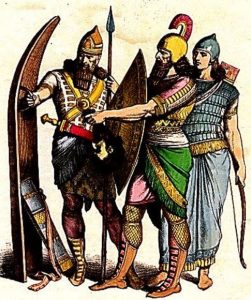
After the founding of the first cities, small states were later formed in Babylonia, with a fortified city in the center. At the head was a prince-priest known as patesi, who was considered as the representative of the tutelary deity of the city, with the god being its true owner.
The most important cities were, in Sumer: Ur, Uruk, and Nippur, the latter was a religious center for the whole country; in Akkad: Agade, Kish, and Lagash or Tello. Both the Akkadians and Sumerians were warrior peoples. There were innumerable wars between the small states, each trying to impose themselves on the others. Through these contests, the country gradually become unified; the smaller states were absorbed.
The unification of Babylonia was achieved by the Sumerians around 2650 BC. The first great empire was that of King Lugalzagesi, which encompassed all of Mesopotamia up to the shores of the Mediterranean. It ceased to exist after his death, but it went down as the first attempt in history to create a universal empire. After Lugalzagesi’s death, the Akkadians established their rule (2600 BC) under the command of Sargon I ‘The Lord of the Four Corners of the World’, establishing an empire that extended throughout Mesopotamia and the eastern part of Asia Minor.
The Babylonians’ political power was of great economic and cultural importance (greater than that of the Egyptians). Babylonian merchants dealt throughout the Eastern world. Babylonian language and writing, weights and measures, law, beliefs and arts spread throughout the East. The idea of a universal empire arose for the first time in Babylonia.
Two centuries after its founding, the Akkadian Empire collapsed as a result of internal disturbances (2400 BC). The Sumerians temporarily regained unity of the empire, but their struggles for supremacy exhausted their forces and finally, the kingdom succumbed to the advance of foreign peoples: the Elamites, and especially the Amorites, a Semitic people who inhabited the Syrian-Arabic desert. The Amorites managed to subdue the Sumerian-Akkadians (2000 BC), creating an empire with Babylon as its capital.
The organization of the Babylonian Empire was the work of Hammurabi (1950 – 1905 BC), who after consolidating internal power, triumphed over the Elamites, incorporated Assyria and Syria, and attained a route to the Mediterranean. But Hammurabi wasn’t a conqueror, he devoted himself before anything to providing his country with peace and order. The emperor controlled the government by divine command, he wasn’t worshiped as a god (like the Egyptian pharaohs). He acted as the representative of the god Marduk, the king of the gods, who was considered the true ruler of the empire. Every year, the king retired to a temple, where he came into direct contact with the deity, who gave him his orders and set out the destiny of the empire. Hammurabi’s most important work was the codification of the laws (The Code of Hammurabi) so that any wronged person could read the laws and find justice.
In the year 1750 BC, the Hittites (an Indo-European people) invaded Mesopotamia and destroyed the Babylonian Empire thanks to an advantageous weapon of war: the horse-drawn chariot. The Hittite kingdom reached its peak in the Fourteenth and Thirteenth centuries BC when they divided rule over the East in a peace treaty with the Egyptian pharaoh Ramses II. The Hittite Empire then spread over all of Asia Minor, the north of Syria and part of Mesopotamia. In the middle of the Twelfth century BC, the empire was destroyed, victim to great migratory waves.
Finally, the destruction of the Babylonian kingdom by the Hittites opened the way for the Kassites (Kurdish-Indo-European people), who ruled for more than five centuries in Babylon, meaning their rule was a period of total decline for the country.
Religion
Like all Semitic peoples and the Egyptians, the inhabitants of Mesopotamia saw the world as inhabited by innumerable spirits, good and bad. They manifested themselves in diverse objects in nature, like stones and plants. The bull and the lion were revered as sacred animals and colossal statues of them were erected in temples and palaces.
The Babylonians and Assyrians accepted the existence of a large number of gods (polytheism), all of whom were celestial beings. They attributed human virtues and passions to them. They were benevolent and righteous gods, there were no evil gods. Evil was caused by demons, evil spirits, more powerful than men, but inferior to gods. They used magic to combat them.
The Babylonians divided the universe into the sky, earth, and ocean, each of which had a god. Anu was the god of the sky, who was above the other deities. Enlil, the counselor of the gods and lord of the humans, and reigned in the land. The third god was Ea, the lord of the waters, who gave wisdom. Beside the worship of these human form gods, they worshiped the stars. The sun god was Shamash (god of justice), the moon god was Sin (god of time), and the planet Venus was Ishtar, goddess of war and love. Each city also had its own tutelary god, with Marduk (Babylon) and Asur (Assyria) standing out. They become national gods, being worshiped as supreme gods. The Babylonians strove to find a solution to the problem of why we live and suffer. According to Babylonian belief, Marduk formed man in his image from a pile of clay kneaded with his own blood.
The problem that worried them most was death. They buried the bodies of their dead because otherwise, the spirit of the dead would become a harmful spirit. If the body received a final tribute, the soul (edimnu) was lowered into the ‘great land’, to the house of darkness, where darkness reigned and the dead had dust for food. This belief left a gloomy and sad impression on spiritual life. Every human being depended on a custodian god, who intermediated with other gods. Therefore, man had to worship this god or else it would abandon him and all sorts of misfortunes would turn towards him. It was necessary to gain the benevolence of the deities through prayers, sacrifices, and magic. What they asked for most was a long earthly life to avoid the torments of the afterlife.
Advances
The Sumerians, intelligent and active, made the country arable, building canals and dikes and drying the marshes. They founded cities and maintained active trade. Of all the advances made by the Sumerians, the most important was the invention of cuneiform writing. In the fourth millennium BC, their art and science had already reached an astounding height.
Civilization 3: Ancient India
Location
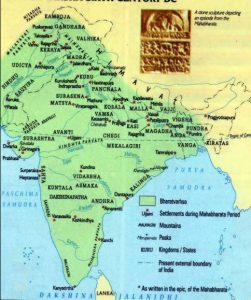
South east of Asia, between the Indus and Ganges rivers, in the so-called Hindustan peninsular.
A wide plain extends around the Indus, a place conducive to cultivating crops. The periodic flooding of the river covered a wide area of land, which, with a system of irrigation canals, was an effective aid in the fertilization of the land.
Society
The Hindus did not mix with subdued people. To preserve the purity of the blood, they established a caste system. Each caste was a closed social group, marriage between members of different castes being prohibited. The caste system remains to this day in India, posing the biggest problem for any social of political reform. The Hindus have three castes: 1) Brahmin or priests; 2) Kshatriya or warriors, which nobles, princes, and kings belong to; and 3) Vaishya, the people who were dedicated to commerce, industry and culture.
The vanquished have two castes: 1) the Shudra, and 2) the untouchables. These castes are despised for being considered impure. They do not belong to the socio-political organism.
Politics
By the year 2500 BC, several powerful cities had been established in the Indus Valley, among them Mohenjo-Daro and Harappa. These cities had strong commercial organization thanks to river navigation in the territory, which allowed them to acquire innovations from other places, especially Mesopotamia. At the head of the government was the priest-king.
Economy
The Indus valleys were used for agricultural work (cotton and grain cultivation). They also entered into commercial relations with Mesopotamia.
Religion
Like the Aryans and other peoples, the Hindus deified the forces of nature, forming a large number of cults. As a consequence of theological speculation, the Brahmanism doctrine was formed. But this was only practiced by the most elite spirits, while a great multitude of the people continued to worship polytheistic deities. However, the same general tendencies predominate in Brahmanism and popular beliefs. Similar concepts and the same divine figures appearing in both, as the first is derived from the latter, forming a purification of it. Beliefs are found to be expressed in the Vedas, the ancient sacred books, and in the Laws of Manu.
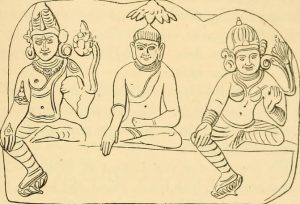
Brahmanism is a pantheistic religion. The world is the material manifestation of the ‘brahma’ ( the Brahma soul of the world, universal soul), which permeates everything. But although the Brahma creates and permeates matter, this is in itself bad. The human body also has no value. The ‘atman’, man’s soul, is condemned to last in the body to atone for old faults. If the atman fails to purify itself, it will have to be reincarnated after the death of the corresponding body into new beings. Depending on whether their behavior has been good or bad, these reincarnations will be in inferior beings (minerals, plants, animals) or superior ones (people, spirits, genies). According to this science of the transmigration of souls, each reincarnation is a punishment for not having achieved purification, but at the same time, it is a new opportunity to achieve it. Through asceticism, the suppression of passions, humiliation and meditation, the soul attains purification until it is finally able to be rid of the body. The ultimate end is the complete separation of matter, the annihilation of the individual soul through its return to the world, which is the one and all, the identification of the Atman with the Brahma. Brahmanism preaches denial of life. It does not want to eliminate the evils of the world, but rather flee the world. The most perfect representative of Brahmanism is the yogi who, abandoning the things of this world, dedicates himself entirely to asceticism, humiliation and meditation.
Brahmanism authenticates and approves the caste system, as according to them each caste signifies a higher stage in the process of the purification of the soul. Buddhism: Brahmanism declined more and more. Against this, against the caste system and against the popular polytheistic cults, it arose in around 500 BC. Gautama Buddha (‘one who is awake’) taught a new doctrine to rid the world of evil. A profound pessimism dominated in his doctrine. The world is drastically evil. Man can be redeemed from evil through charity, compassion and love. Through the renunciation and suppression of passions and appetites, in favor of truth etc., the soul enters Nirvana, where it is extinguished.
Buddhism is a very peculiar religion because it is one without a god, it is complete atheism. The world and man are intrinsically evil. Living is suffering. It is necessary to annihilate individual existence to redeem oneself from suffering. Happiness lies in extinction, the entrance to Nirvana. Initially, Buddhism was widespread in India, but as it was addressed to all men and opposed to the caste system, it then led to a powerful reaction from Brahmanism. Finally, it disappeared almost completely. Instead, it spread throughout East Asia (Burma, Siam, Indochina, Tibet, Mongolia, China, Japan). Buddhism originally being a religion without a god, it didn’t have a cult at first. There were no temples, ceremonies nor prayers. But as the masses couldn’t believe in a purely abstract religion, the divinized Buddha himself.
Advances
The Hindu cities were noted for their progress; each one had temples, a public bath with central heating, lounges, and granaries. The streets were lined with houses with terraces, many two stories high, built with baked bricks, and people used bitumen on ceilings and walls to avoid damp. Indus plumbing was the most advanced of its time. The large houses had wells for drinking water and bathwater, and a drainage system. The cities prospered for almost a thousand years, but in around 1700 BC, they were devastated by earthquakes and floods. Indian sculptors made terracotta figures as well as stone ones. In Mohenjo-Daro, carved seals with animal figures and symbols from a form of writing not yet discovered have been found.
Civilization 4: Ancient China
Location
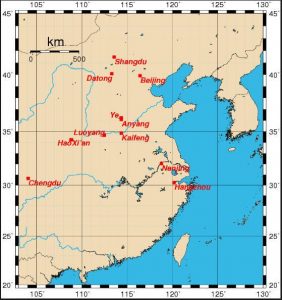
In the fertile valleys of the Yellow River and the Yangtze, one of humanity’s most fascinating and fruitful civilizations developed: the Chinese.
Politics
An empire controlled by the emperor was formed, which passed into the hands of several dynasties or families:
- Shang Dynasty: (circa 1766 – 1027 BC) This dynasty was established following a series of tribal wars. It extended up to Mongolia and along the valley of the Yellow River. Its capital city was Yinxu. Shang society was highly developed and governed by a hereditary class of aristocrats. At the head was the king, who presided over a military nobility and chose territorial governors. Between this aristocratic class and the commoners, there was a priestly cult. Their economy was based on agriculture, which included the cultivation of millet, wheat and barley. They mastered bronze metallurgy and also their delicate jade sculptures and silk fabrics were famous. The cult to the deceased emperors ruled and occasionally they would perform human sacrifices. The Shang dynasty came to an end weakened by neighboring peoples and was replaced by the Zhou.
- Zhou Dynasty: (circa 1027 – 256 BC) This was the last dynasty of kings before the imperial dynasties. Their capital was established in the city of Xi’an and they divided the kingdom into several states controlled by a local governor, who completed central orders. Over time, these states grew more and more independent, and the dynasty’s power was weakened. The cities grew, forming a commercial class that used money instead of bartering. There was great cultural development in this period; there were great thinkers and philosophers, such as Confucius, the creator of Confucianism (see box) and Lao Tzu, the creator of the Tao Te Ching and Taoism, which worships the spirits of nature and ancestors. A large number of great books were produced, including the I Ching (or Classic of Changes), the Shijing (or Classic of Poetry) among others. In the year 256 BC, the Zhou dynasty finally came to an end when the central government lost power and broke into seven great states.
- Ch’in or Qin Dynasty: (circa 221 – 207 BC) The seven separate states fought among themselves to control China. Finally, the Ch’in or Qin were victorious and their king, Zheng, established a heavily authoritarian great empire (221). In addition, he named himself Qin (or Ch’in) Shi Huang Di (‘First Emperor of China’).
The emperor carried out a series of administrative and economic measures, in addition to promoting cultural unification. Among his famous works are the construction of the Great Wall of China, which was built to defend the empire from invasions. This was later extended and reconstructed by subsequent dynasties. Due to the harsh government and heavy taxes, when the emperor died, in 210 BC, civil war broke out. This, in addition to the continuous threats of invading peoples, caused the empire to fall and the Han came to power.
Society
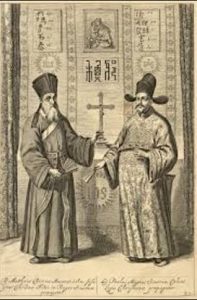
Aristocratic society. This means a society with strictly identified social stratum, in which the most powerful class rules the least powerful. At the head is the king, who presided over a military nobility and chose territorial governors, who were obliged to offer their services in military enterprises. In this sense, we can see a characteristic parallelism with European feudalism that would take place around a thousand to two thousand years later, in a territory with which there would only be trade routes, and therefore, cultural exchange around 200 BC (Silk Road). On a lower level were the commoners, who were most people, and who didn’t have any decision-making power. Between the aristocratic class and the commoners was a learned priestly social stratum who dealt with governmental and administrative documents.
Economy
Based on rice cultivation. In addition, millet, wheat, barley, and rice were grown. Silkworms were also tended to, and they bred dogs, pigs, sheep, and oxen.
Religion
They followed the principles of Confucius. Confucianism, more than a religious system, is a moral one, based on the importance of goodness and the spirit. They never had a specifically designed religion. But even so, it is known that, like most Oriental civilizations, they worshiped their ancestors (Animism, a definition in the religious sense) by creating altars and statues for them, and equipping them with a special knowledge and a series of supernatural powers. They also believed that the soul of the ancestors, or their plans, could be read in the stars, which is known as Chinese astrology, but it was never especially advanced, unlike that of the Babylonians, Egyptians or Hindus. Like other cultures of the time, they worshiped a series of different gods depending on the region, inherited from the distinct populations of the Yangshuo and Longshan cultures, sometimes natural, or representing human attitudes or feelings. Their gods were anthropomorphous and zoomorphic, so they are defined as polytheists. The most important of the gods was Shangdi ‘the Supreme Deity’.
Advances
Two philosophical currents were formed, the most important ones in China, which remain to this day: Confucianism (moral principles from the great philosopher Confucius) and Taoism (harmony with nature).
The Great Wall of China was built. Writing, almost as it is today, was created. Formation of hydraulic works and extremely important cultural links (Silk Road). Invention and development of the paper industry. Buddhism flourished. The Grand Canal linking the Yangtze and Yellow rivers was built. There was great artistic development, in painting and poetry, and in cartography and mathematics.

